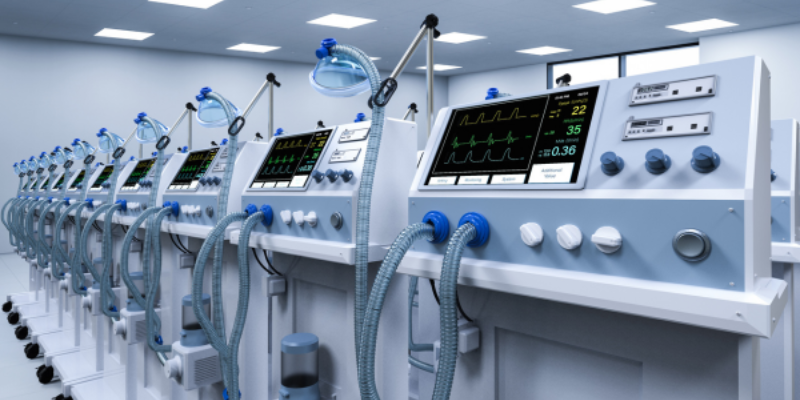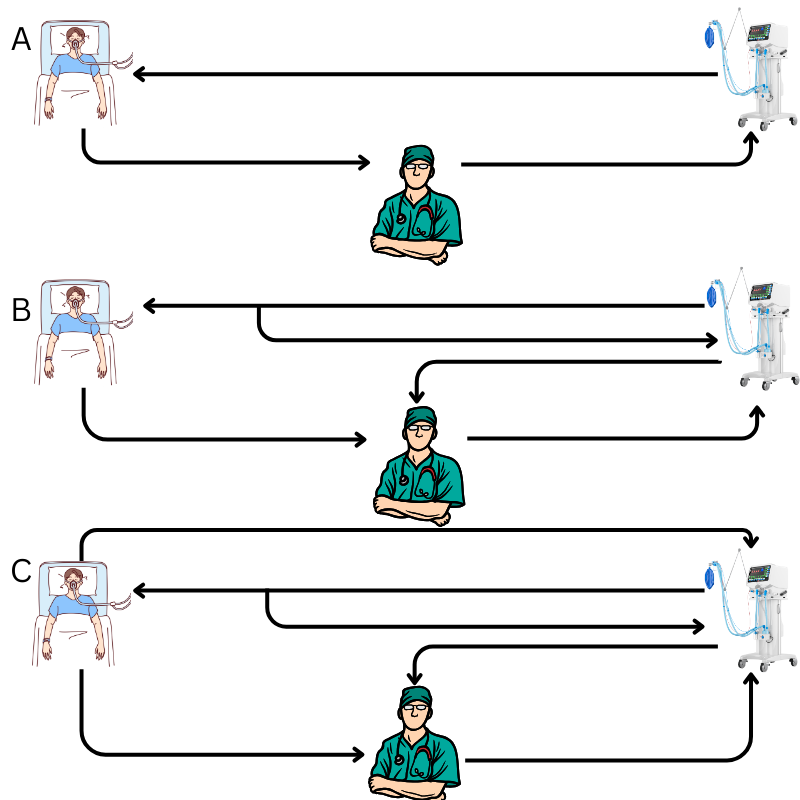Ventilators are crucial in the management of patients with respiratory failure, providing essential support when the person cannot breathe independently. They are essential in intensive care units (ICUs) to treat conditions such as pneumonia, chronic obstructive pulmonary disease (COPD), acute respiratory distress syndrome (ARDS) and complications from COVID-19 or during surgical procedures requiring anesthesia. The ability to deliver precise oxygen levels and aid in carbon dioxide removal is crucial for patient survival and recovery. They assist in delivering oxygen to the lungs and removing carbon dioxide, ensuring that vital organs receive adequate oxygen while reducing the strain on the respiratory muscles.
Table of Contents
Technological advancements have brought about a lot of changes in the design of ventilators due to the integration of microprocessor technology, high precision sensors, artificial intelligence algorithms, which have made ventilators more precise, user-friendly and more beneficial to the patient. Modern ventilators now come with features such as touchscreen interface, automatic alarms, remote monitoring, and rich integration with electronic health records, which improve patient outcomes and physician efficiency. Readers will learn in this article how ventilators will evolve with more advanced AI, IoT connectivity, and predictive analytics, paving the way for smarter, more autonomous devices that will provide better comfort and personalized respiratory support while ensuring better remote health management.

The Evolution of Ventilator Technology
If we look at the evolution of ventilators, a lot has happened in the last few years. Let us briefly look at how the ventilator we are looking at now started, what was added to it and what major changes have taken place.
2. First Generation (1950s-1960s)
- Positive-pressure ventilators
- Volume-controlled ventilation
- Basic monitoring systems
3. Second Generation (1970s-1980s)
- Microprocessor-controlled ventilators
- Pressure-support ventilation
- Synchronized intermittent mandatory ventilation (SIMV)
4. Third Generation (1990s-2000s)
- Advanced monitoring systems
- Noninvasive ventilation
- Portable ventilators
5. Modern Ventilators (2010s-present)
- Intuitive touchscreens
- Automated alarms
- Remote monitoring
- Predictive analytics
- Advanced AI integration
- IoT connectivity
- Personalized ventilation modes
Now we will talk about some major changes in the advancement of ventilators, due to which ventilators are making a huge contribution in critical care.
- Integration of microprocessors: Microprocessors were first developed in 1982, allowing the patient’s breathing curve graph to be monitored. Later, many advancements of ventilators were made with the help of microprocessors such as customized gas delivery that was more sensitive to the patient.
- Non-invasive ventilation: Non-invasive ventilation reduces the need to intubate the patient, yet provides effective respiratory support. It was first used in the 1940s, then in the 1980s for chronic breathing problems and then in the 1990s for acute respiratory failure.
- Portable ventilation: Portable ventilators were first introduced in the 1970s by Dr. Forrest Bird and have undergone many developments and today recent devices such as the Life2000 manufactured by Breathe Technology are lightweight and wearable, allowing the patient to move around while providing respiratory support.
- Closed-loop ventilation: Closed-loop ventilation uses artificial intelligence-based algorithms to monitor the patient’s autonomic responses and adjust settings accordingly, as well as intervention from healthcare providers to reduce the risk of ventilator-induced lung injury.
Recent Innovations in Ventilator Technology
Recent innovations in ventilator technology have drastically changed patient respiratory care systems such as:
- 3D Printed Ventilator : This technology was developed to overcome the shortage of ventilators due to the COVID pandemic. This device can be made in a very short time and at a low cost for emergency situations, however its testing is still going on for patient safety and quality care.
- Wearable Ventilator : Wearable ventilators were invented due to the COVID-19 pandemic, which is most beneficial for patients who have chronic respiratory problems due to COVID-19, neuromuscular disease or restrictive thoracic disorder, etc. With wearable ventilators, the patient can move around and these are available in various sizes.
- Electrical Impedance Tomography (EIT): EIT allows real-time imaging of lung function without exposing the patient to radiation like CT scan and facilitates the physician to make timely decisions by providing continuous monitoring of lung functions.
- Remote monitoring capabilities: Remote monitoring capabilities allow healthcare professionals to monitor a patient’s real-time vital signs and settings from anywhere.

The Role of AI and Machine Learning in Ventilators
AI and machine learning have brought unprecedented changes in healthcare and ventilator technology, improving patient care and outcomes.
1. Automatic adjustment: Artificial intelligence powered ventilators monitor the patient’s breathing pattern, respiratory rate and oxygen level data in real-time and accordingly determine the patient’s tidal volume, pressure and flow rate based on the patient’s needs and ultimately reduce ventilator-related complications.
2. Real-time monitoring: Artificial intelligence refers to a broad field of research to create machines that can act like humans having the capability of reasoning, problem solving, learning, perception and natural language processing (NLP). And because of these capabilities AI algorithms can analyze a large amount of data of respiratory patterns, and it can indicate respiratory distress and failure which ultimately leads to early intervention of the physician and enhances patient safety.
3. Decision support for physician: AI and machine learning algorithms are used to analyze the complex data of the patient and identify trends and patterns that are difficult for a human to identify and can also tell the best time and help the physician to make proactive decisions.
4. Automated Weaning: The most critical part in ventilator management is when the patient is being weaned off the device and then machine learning comes in which can predict the likely time of weaning by analyzing patterns through respiratory data.

The Future of Ventilator Technology
The future of ventilators is unimaginable as it will evolve everything around it which today seems to be a vital part of managing ventilators and patient care and provide more convenience and enhance more sustainability in the production of advanced ventilators. Let us look at some of them:
1. Integration of IoT in ventilators: Internet of Things (IoT) integration in ventilators can enable ventilators to communicate with doctors, other medical devices, hospital systems, and electronic health records (EHR) and allow doctors to track patients’ vital information, adjust settings, and receive alerts from anywhere.
2. Power efficiency: Battery is a very important part of portable ventilators. Future ventilators will incorporate advanced battery technology like lithium-polymer or graphene batteries, which will have faster charging and longer life quality. Even hybrid systems are on the way to advancement of ventilators that combine battery power with solar charging.
3. Eco-friendly materials and sustainability: Sustainability is a growing priority in medical assets. Future ventilators will be produced using eco-friendly materials such as biodegradable plastics, bioplastics (e.g., polylactic acid (PLA), recyclable plastics (polypropylene (PP)), sustainable metals (e.g., aluminium), etc. This will reduce waste and increase sustainability in production.
4. Voice-controlled and autonomous ventilators: Have you ever imagined that a ventilator will respond to your voice command, you will see it in the near future as many innovative companies and research institutes are exploring these technologies to make respiratory care more responsive and advanced.

Conclusion
Ventilator technology is advancing towards more intelligent, autonomous systems that integrate AI, IoT, and sustainable materials. These innovations aim to enhance patient care, energy efficiency, and adaptability, positioning ventilators to become more responsive and eco-friendly in the future.
“Embrace innovation to breathe life into progress; the future of healthcare is built on the strength of each technological breakthrough.”

Pingback: Ventilators 101: An Easy Guide for Biomedical and Nursing Beginners in Healthcare - impbiomed.com